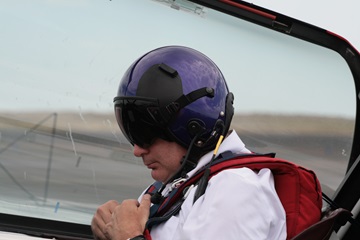Learning to fly aerobatic figures and sequences is the best way to become a precise, confident, safe pilot. It's "pure flying" that demands the most from a pilot and airplane. But it can be unforgiving of lapses of discipline, poor training, and equipment that's not maintained to a high standard.
There is no substitute for instruction to learn to safely perform aerobatic figures. You must learn not only how to safely perform aerobatic figures, but especially must learn and practice recovery from the unusual attitudes in which you can find yourself when you make a mistake. Only after you are a safe and confident aerobatic pilot, should you fly "acro" solo, attend an aerobatic camp (see Coaching and Camp), and prepare to participate in your first contest.
There is also no substitute for an airplane that meets the standard for certification in the Aerobatic Category. There are many Experimental Category airplanes that meet this standard; Pitts Special models are renowned examples. Light Sport Airplanes that meet the standard are very rare; don't assume any LSA meets the standard. Please watch Airplanes for Aerobatics for more information.
Safe aerobatic flying requires dual instruction from an experienced aerobatic instructor. Watching YouTube videos and reading books on aerobatic flying will help with understanding the theory but are never a substitute for instruction.
Please see the information on the site "Aerobatic Instruction" page for instructional resources in Washington and Arizona. During the PNW inclement weather months, consider a vacation in California and Oregon to complete an aerobatic course.
"Box monitors" keep the aerobatic box at the contest site under observation to mitigate the risk of potential traffic conflicts. Your practice session performance in "the box" could be observed by experienced competitors and judges. Coordinate with the box monitors to obtain their impressions after your practice sessions. They might offer you suggestions to improve your performance. They might also see safety issues that could be brought to your attention.
The pilot's credentials and airplane must pass a technical inspection. The technical inspection standard includes examination of the pilot's (mandatory) emergency parachute for a current inspection.
A prescribed, published sequence of aerobatic figures called the "Known" is the first flight of the contest for every competitor. Like all contest flights, it's evaluated by at least three teams of judges. If the judges determine that a pilot's performance of the Known sequence indicates a safety risk, the pilot can be disqualified from subsequent flights during that contest.
Whenever we fly, we want to be physically at our best. Flying aerobatic figures imposes greater physical demands on pilots than Normal or Utility category flight loads. You should not fly "acro" if you're even a little under the weather (no pun intended): you should be healthy, feeling well, and hydrated.
Please take the time to study the Aerobatic_Safety_Presentation Wes Liu, which uses examples from a National Aerobatic Competition site in Texas. The Nationals are now conducted in Salina, KS.

Every acro flight should also include a rehearsal of bailout procedures, for example: the steps to release/jettison the airplane canopy or door, release seat and shoulder harness fasteners, and exit the airplane.
Below, Chapter 67 pilots are participating in a "Bailout Seminar" conducted at the close of a Judge's School session.
